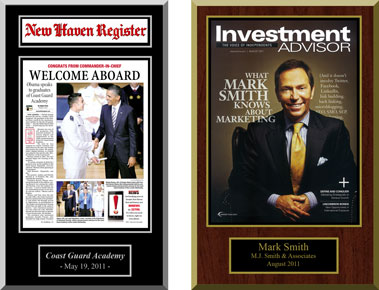There are a variety of reasons why you might want to get articles published in major newspapers and magazines. A feature in your local paper can attract an enormous amount of free publicity.
And unlike an advertisement, when people see articles published by you, it makes you and your business more legitimate in the mind of readers, potential customers and clients.
Believe it or not but it’s easier than ever to get your name in print. As long as you follow a few simple suggestions and behave in a fully professional manner, you can probably convince a newspaper, website or magazine editor to publish your article in a just a few months.
At That Great News, after 15 years of experience, we wanted to share a few tips with you for getting articles published.
Step 1: Become an Expert
Whatever your niche, be sure that you are the go-to person for that topic. If you’re a doctor, lawyer, accountant, car or insurance salesperson, make yourself the authority in your area.
Step 2: Identify Publications that Suit Your Expertise
These days, newspapers are looking for way to slash costs any way they can. One thing they do is populate their hyper local sections with articles published by locals and about locals. Also, alternative weekly newspapers and local magazines always need a steady flow of new content.
Philadelphia Weekly, for example, is an alternative newspaper that caters to residents in and around metropolitan Philadelphia. Every week, without fail, editors need to have fresh content. The Houston Chronicle is a major newspaper read by hundreds of thousands of Houston residents. The paper also publishes smaller, hyper local papers for surrounding suburbs, like Ultimate Woodlands. These publications need articles published for their print and web properties flowing in nonstop.
Step 3: Track Down the Right Contact Person
If you are pitching your article to the wrong editor, chances are she will not return your calls or emails and she won’t let you know who you should be contacting. It has nothing to do with manners, but rather, time. As stated in Step 2, editors need to provide new content on a daily basis. There’s just no time to return every call.
Instead, do your homework. Newspapers and magazines have a masthead, usually found at the front of the publication, listing the editor in charge of each section. If your expertise is in health, you want to pitch the health editor. If you want to write about restaurants or pop culture, contact the entertainment editor.
Some publications list the section editor directly on the page that content is published. Again, editors need new articles published all the time. They want you to contact them with great story ideas!
Step 4: Persistence
There is a very fine line between persistence and being overbearing. It’s hard to know ahead of time whether the editor you’re contacting is a phone person or an email person. For your initial contact, it’s best to take both approaches. Draft a very professional email explaining what you want to write. Be sure it contains a paragraph describing who you are and why you are qualified to write the article. Outline your story in the second paragraph and in the third paragraph, let the editor know how to reach you and give him a day and time you will place a follow-up call to discuss your idea in depth. Your cover letter should be short, concise and to the point.
When you call the editor, remind her of the day you sent the email, who you are and what your idea is. Chances are you will only get a voicemail message. But regardless of whether you get a real person or voicemail, be sure to keep your message brief and to the point. Leave your contact number in a clear voice and repeat it one time. By identifying the date you sent your pitch by email, it will be easier for the editor to find it. It wouldn’t hurt to also leave your email address since some editors prefer corresponding this way.
Step 5: Don’t Be Pushy
It’s best if you follow-up with your editor about a week after initial contact. If you inundate her with daily phone calls and emails, you could inadvertently end up on her spam list.
Step 6: Keep In Touch
There could be dozens of reasons why you’re not getting a call back. One is that the publication had recently published a similar story. That’s why you need to have more than one idea. For your second pitch, you can say something along the lines of this:
Hello:
You may recall that I pitched a story idea about a new weight loss program. Since I haven’t heard from you, I thought that maybe you are not able to use my idea. As a fitness expert who is very active in our community, I’d like to suggest writing an article about how to get in your workouts during the holidays. I’m happy to talk to you about this idea more in depth. You can reach me at 555-1234 or email me at (your email address here)
Often, editors have a stable of writers that they use regularly. To break in and get your articles published, it’s important to always pitch timely, useful story ideas. And keep an eye on the publications you’re pitching to be sure that your idea has not recently been used. You’re more likely to get an editor to hear out your full voicemail message, read your pitch and get your articles published if you’re presenting her with ideas that have not been used in the past six months.
Step 7: If You Have a Portfolio, Share It
One problem new writers always come up against is that editors don’t want to work with you until you have a portfolio of work. But how can you get articles published if you don’t have a portfolio? Fortunately, the internet has made it easy for almost anyone to get a byline. Websites are always looking for unpaid writers. And unlike established newspapers and magazines, you can submit a fully written piece without getting approval ahead of time. Every time a website publishes your article, be sure to save that document as a PDF and include it in your email when you’re pitching newspaper and magazine editors. After you’ve introduced yourself and pitched your idea, you will want to say something like this:
Thank you for your consideration. I will attach samples of my published work for your review.
What is That’s Great News?
We specialize in mounting magazine and newspaper articles for businesses, sports figures, publishers, restaurants, hobbyists, and families from all over the United States and Canada. We offer a way for those featured in a publication to make a lasting impression by preserving and displaying their success. You’ve probably seen our wall displays on some of the best business walls in the country.
If you’re featured in an article, we know it, and we make it our business to offer you our custom service. We subscribe to thousands publications. In addition we receive nearly every magazine, business journal, and trade publication from every city, state, and region, covering a wide variety of subjects. Our account managers work with businesses and individuals as they appear in the news, delivering a product that prominently and tastefully displays the article or achievement in which they have been featured.
Have an article already published want to preserve it: click this button to get started







